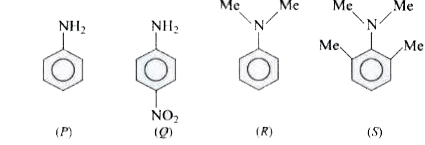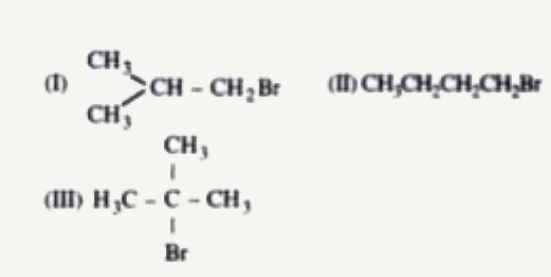Arrange the following compounds in increasing order of their ionic character :
SnC2,SnCl4,SiCl4,SnF4,SnF2
3Å
5.33Å
6.88Å
48Å
The correct Answer is:3
To arrange the compounds SnC₂, SnCl₄, SiCl₄, SnF₄, and SnF₂ in increasing order of their ionic character, we will follow these steps:
Step 1: Understand Ionic and Covalent Character
Ionic character refers to the extent to which a compound exhibits ionic bonding, while covalent character refers to the extent to which a compound exhibits covalent bonding. According to Fajans' rules, the covalent character in an ionic compound is influenced by the charge and size of the ions involved. A higher charge and smaller size of the cation lead to greater covalent character, which in turn means lower ionic character.
Step 2: Determine the Oxidation States
Identify the oxidation states of the cations in each compound:
- SnC₂: Sn has an oxidation state of +2.
- SnCl₄: Sn has an oxidation state of +4.
- SiCl₄: Si has an oxidation state of +4.
- SnF₄: Sn has an oxidation state of +4.
- SnF₂: Sn has an oxidation state of +2.
Step 3: Compare Cation Charges
From the oxidation states, we see:
- SnC₂ and SnF₂ have a +2 charge.
- SnCl₄, SiCl₄, and SnF₄ have a +4 charge.
Step 4: Analyze the Size of Anions
The size of the anions also plays a crucial role in determining covalent character:
- Fluorine (F) is smaller than chlorine (Cl).
- Therefore, for the same cation charge, compounds with Cl will have a higher covalent character compared to those with F.
Step 5: Compare Covalent Character
Now, we compare the covalent character based on cation charge and anion size:
- SiCl₄: +4 charge on Si and larger Cl anion → higher covalent character.
- SnCl₄: +4 charge on Sn and larger Cl anion → high covalent character.
- SnF₄: +4 charge on Sn and smaller F anion → lower covalent character than SnCl₄.
- SnC₂ and SnF₂: +2 charge on Sn → higher ionic character compared to +4 compounds.
Step 6: Final Comparison
Now we can arrange the compounds based on their covalent character, which inversely relates to ionic character:
1. SiCl₄ (most covalent, least ionic)
2. SnCl₄
3. SnF₄
4. SnCl₂
5. SnF₂ (least covalent, most ionic)
Conclusion
The increasing order of ionic character is:
SiCl₄ < SnCl₄ < SnF₄ < SnCl₂ < SnF₂
Ionic character refers to the extent to which a compound exhibits ionic bonding, while covalent character refers to the extent to which a compound exhibits covalent bonding. According to Fajans' rules, the covalent character in an ionic compound is influenced by the charge and size of the ions involved. A higher charge and smaller size of the cation lead to greater covalent character, which in turn means lower ionic character.
Identify the oxidation states of the cations in each compound:
- SnC₂: Sn has an oxidation state of +2.
- SnCl₄: Sn has an oxidation state of +4.
- SiCl₄: Si has an oxidation state of +4.
- SnF₄: Sn has an oxidation state of +4.
- SnF₂: Sn has an oxidation state of +2.
From the oxidation states, we see:
- SnC₂ and SnF₂ have a +2 charge.
- SnCl₄, SiCl₄, and SnF₄ have a +4 charge.
The size of the anions also plays a crucial role in determining covalent character:
- Fluorine (F) is smaller than chlorine (Cl).
- Therefore, for the same cation charge, compounds with Cl will have a higher covalent character compared to those with F.
Now, we compare the covalent character based on cation charge and anion size:
- SiCl₄: +4 charge on Si and larger Cl anion → higher covalent character.
- SnCl₄: +4 charge on Sn and larger Cl anion → high covalent character.
- SnF₄: +4 charge on Sn and smaller F anion → lower covalent character than SnCl₄.
- SnC₂ and SnF₂: +2 charge on Sn → higher ionic character compared to +4 compounds.
Now we can arrange the compounds based on their covalent character, which inversely relates to ionic character:
1. SiCl₄ (most covalent, least ionic)
2. SnCl₄
3. SnF₄
4. SnCl₂
5. SnF₂ (least covalent, most ionic)
The increasing order of ionic character is:
SiCl₄ < SnCl₄ < SnF₄ < SnCl₂ < SnF₂
Topper's Solved these Questions
- CHEMICAL BONDINGBOOK - RESONANCE ENGLISHCHAPTER - CHEMICAL BONDINGEXERCISE - Inorganic chemistry (Chemistry Bonding)
49 Videos
- CHEMICAL BONDINGBOOK - RESONANCE ENGLISHCHAPTER - CHEMICAL BONDINGEXERCISE - ORGANIC CHEMISTRY(Fundamental Concept )
6 Videos
- ATOMIC STRUCTUREBOOK - RESONANCE ENGLISHCHAPTER - ATOMIC STRUCTUREEXERCISE - ORGANIC CHEMISTRY(Fundamental Concept )
16 Videos
- CHEMICAL EQUILIBRIUMBOOK - RESONANCE ENGLISHCHAPTER - CHEMICAL EQUILIBRIUMEXERCISE - Advanced Level Problems (Part-3)(Stage-5)
2 Videos
Similar Questions
Knowledge Check
Arrange the following compounds in increasing order of acidity :
 AP>Q>R>SBS>Q>R>PCS>R>P>QDR>S>P>Q
AP>Q>R>SBS>Q>R>PCS>R>P>QDR>S>P>QArrange the following compounds in increasing order of basicity :
 AS>R>Q>PBS>R>P>QCP>Q>R>SDR>Q>P>S
AS>R>Q>PBS>R>P>QCP>Q>R>SDR>Q>P>SArrange the following compounds in increasing order of their heat of combustion :
 AP<Q<R<S<TBT<S<P<Q<RCQ<P<R<T<SDR<S<T<Q<P
AP<Q<R<S<TBT<S<P<Q<RCQ<P<R<T<SDR<S<T<Q<P
Arrange the following compounds in increasing order of their acidic strength.

View SolutionArrange the following compounds in increasing order of their boiling points.

View SolutionArrange the following compounds in the increasing order in their densities.

View SolutionArrange the following in the increasing order of ionic character : KCl,MgCl2,CaCl2,BeCl2.
View SolutionArrange the following in increasing order of acidic character:
CrO,Cr2O3andCrO3.
View Solution

